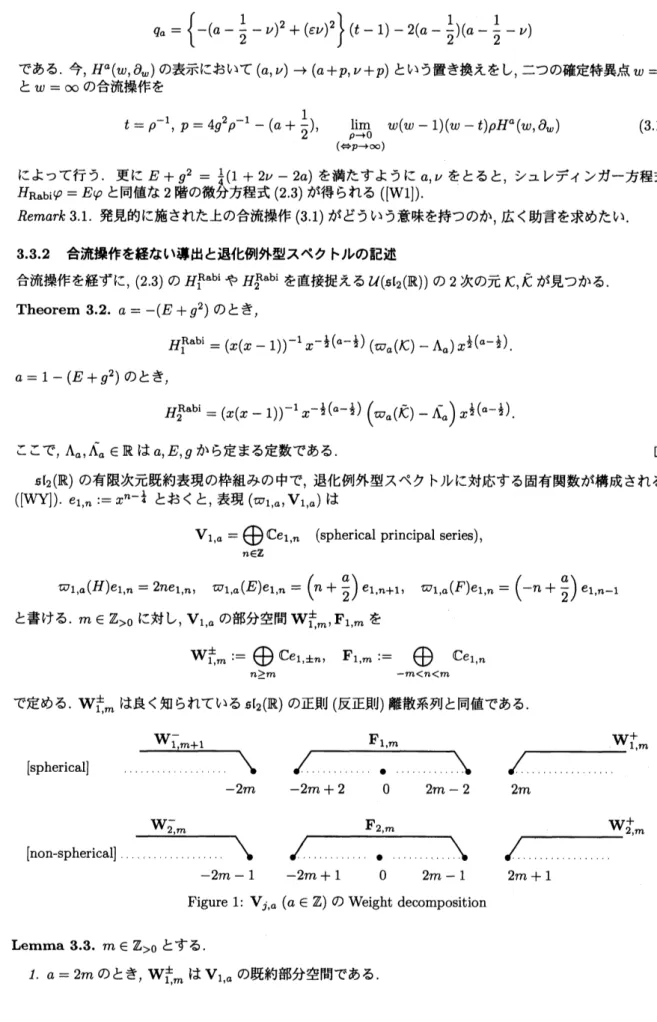Quantum Rabi’s
model and
non-commutative
harmonic
oscillators
九州大学マスフォアインダストリ研究所
若山正人(
述
)
九州大学大学院数理学府 井上公人(記)
November
10,
2014
1
非可換調和振動子
非可換調和振動子$($NcHO) は$Q:= (\alpha \beta)(-\frac{1}{2}\frac{d^{2}}{dx^{2}}+\frac{1}{2}x^{2})+(1 -1)(x \frac{d}{dx}+\frac{1}{2}) (\alpha, \beta\in \mathbb{R})$
で定義される微分作用素である.$\alpha,$$\beta>0,$ $\alpha\beta>1$ のとき,$Q$ は空間$\mathbb{C}^{2}\otimes L^{2}(\mathbb{R})$上での自己共役作用素と
なり,正の離散スペクトル
$0<\lambda_{0}<\lambda_{1}<\cdots<\lambda_{n}<\uparrow\infty,$
を持つ ([P]). これは,ある種の数学的動機から1998年にA. Parmeggiani 氏と講演者により導入された.
$\alpha=\beta$ のときは,二つの調和振動子の組とユニタリ同値となり,スペクトル$\{\sqrt{\alpha^{2}-1}(n+\frac{1}{2})|n\in \mathbb{Z}_{\geq 0}\}$ を
重複度2で持つ.一般に$\alpha\neq\beta$のときのNcHO のスペクトル解析は著しく困難である.しかし,NcHOの
スペクトルゼータ関数を級数
$\zeta_{Q}(s)=\sum_{n=0}^{\infty}\lambda_{n}^{-s} (\Re s>1)$
で定めると,これは全複素平面に有理型関数として解析接続され,$s=1$ のみを極に持つ.また,リーマン
ゼータ関数と同様に負の偶数点で自明な零点を持っている ([IW1]). さらに,$\zeta_{Q}(2)$,$\zeta_{Q}(3)$,$\zeta_{Q}(4)$から自然に
定まるアペリ数の類似物が現れ,保型性や楕円曲線との関係が示されるなど,豊富な数論的性質を有するこ とが分かつている ([KW1], [KW2], [LOS], [W2]).
1.1
Heun
の微分方程式NcHO のスペクトル問題$Q\varphi=\lambda\varphi$は,4つの確定特異点$w=0$, 1,$\alpha\beta,$$\infty$を持つ2階のHeun型微分方程式
の,ある複素領域上の正則関数解と同値である.次の
Theorem
のうち,奇関数の方は [O] によって知られていた.
Theorem 1.1 ([W1]). 次の線形同型写像が存在する:
Even:$\{\varphi\in L^{2}(\mathbb{R}, \mathbb{C}^{2})|Q\varphi=\lambda\varphi, \varphi(-x)=\varphi(x)\}arrow\sim\{f\in \mathcal{O}(\Omega)|H_{\lambda}^{+}f=0\},$
Odd:$\{\varphi\in L^{2}(\mathbb{R}, \mathbb{C}^{2})|Q\varphi=\lambda\varphi, \varphi(-x)=-\varphi(x)\}arrow\sim\{f\in \mathcal{O}(\Omega)|H_{\lambda}^{-}f=0\}.$
ここで $\Omega\subset \mathbb{C}$ は $0,$$1\in\Omega,$$\alpha\beta\not\in\Omega$ を満たす単連結領域で,$\mathcal{O}(\Omega)$ は$\Omega$ 上の正則関数全体の集合である.
$H_{\lambda}^{\pm}=H_{\lambda}^{\pm}(w, \partial_{w})$ はそれぞれHeun の常微分作用素で,次で定義される:
$H_{\lambda}^{+}(w, \partial_{w}):=\frac{d^{2}}{dw^{2}}+(\frac{\frac{1}{2}-p}{w}+\frac{-\frac{1}{2}-p}{w-1}+\frac{p+1}{w-\alpha\beta})\frac{d}{dw}+\frac{-\frac{1}{2}(p+\frac{1}{2})w-q^{+}}{w(w-1)(w-\alpha\beta)},$
ここで$p=p(\nu)$,$\nu=\nu(\lambda)$ は次の関係式で定義される.
$p= \frac{2\nu-3}{4}, \nu=\frac{\alpha+\beta}{2\sqrt{\alpha\beta(\alpha\beta-1)}}\lambda.$
また,これらの Heunの作用素のアクセサリパラメータ $q^{\pm}=q^{\pm}(\lambda)$ は$\alpha,$$\beta$ と $\lambda$ によって次のように表さ
れる. $q^{+}= \{(p+\frac{1}{2})^{2}-(p+\frac{3}{4})^{2}(\frac{\beta-\alpha}{\beta+\alpha})^{2}\}(\alpha\beta-1)-\frac{1}{2}(p+\frac{1}{2})$ , $q^{-}= \{p^{2}-(p+\frac{3}{4})^{2}(\frac{\beta-\alpha}{\beta+\alpha})^{2}\}(\alpha\beta-1)-\frac{3}{2}p.$ 口
1.2
スペクトルの構造 [PW2]で固有関数を変形した形のエルミート関数で展開し,固有値と固有関数の連分数展開を与えた.NcHOの固有関数$\varphi\in L^{2}(\mathbb{R}, \mathbb{C}^{2})$ が有限個のエルミート関数で展開されるとき,
$\varphi$ を有限型と言う.また,NcHO
の固有値$\lambda$
が有限型の固有関数に対応しているとき,$\lambda$ を有限型と言う.有限型でない固有関数及び固有値
を無限型と言う.有限型 (resp. 無限型) の固有値全体を$\Sigma_{0}$ (resp. $\Sigma_{\infty}$) で表す.同様に,$\varphi(-x)=\pm\varphi(x)$ を
満たす固有関数に対応する固有値の集合をそれぞれ$\Sigma^{+},$$\Sigma^{-}$ と書く.以上より,次のような NcHO の固有値
の分類を考える: $\Sigma_{0}^{\pm}:=\Sigma_{0}\cap\Sigma^{\pm}, \Sigma_{\infty}^{\pm}:=\Sigma_{\infty}\cap\Sigma^{\pm}.$ 定義より,これら 4 つの集合は互いに共通部分を持ち得ることに注意する. [NNW], [PW2] と上の Theorem 1.1 を用いることにより,NcHO のスペクトルについて以下の図で表され る関係が分かっている.図中の各領域の中の数字は,そこに属す固有値の重複度である. [HS] で基底ベクトルの固有値は重複度が 1 であり,$\Sigma_{\infty}^{+}$ に属すことが示されている.また,有限型の固有値 について以下が分かっている ([W1]).
$\Sigma_{0}^{+}\subset\{\lambda=2\frac{\sqrt{\alpha\beta(\alpha\beta-1)}}{\alpha+\beta}(2L+\frac{1}{2})|L\in \mathbb{N}\},$ $\Sigma_{0}^{-}\subset\{\lambda=2\frac{\sqrt{\alpha\beta(\alpha\beta-1)}}{\alpha+\beta}(2L+\frac{3}{2})|L\in \mathbb{N}\}.$
2
量子ラビ模型
量子ラビ模型は量子情報技術を目指す実験の理論背景となっており,次のハミルトニアンで記述される.
$H_{Rabi}/\hslash=\omega a^{\dagger}a+\triangle\sigma_{z}+g\sigma_{x}(a^{\dagger}+a)$. (2.1)
ここで$a^{\dagger}=(x-\partial_{x})/\sqrt{2},$ $a=(x+\partial_{x})/\sqrt{2}$は角振動数$\omega$のポゾニックモードに対する生成消滅演算子,
$\sigma_{x}=(\begin{array}{ll}0 11 0\end{array}),$ $\sigma_{y}=(\begin{array}{ll}0 -ii 0\end{array}),$ $\sigma_{z}=(\begin{array}{ll}1 00 -1\end{array})$ は二準位系に対するパウリ行列,$g>0$ は二準位系とボゾ
ニックモードの間の結合強度,$2\Delta>0$は二準位間のエネルギー差である.以下,一般性を失わずに $\hslash=\omega=1$
2.1
Heun
の微分方程式
Bargmann変換$\mathcal{B}$ を
$( \mathcal{B}f)(x)=\sqrt{2}\int_{-\infty}^{\infty}f(x)e^{2-\tau^{z^{2}}}\pi xz-\pi x^{2\pi}dx$
で定める.$\mathcal{B}$により,以下のような生成消滅演算子の変換
$a^{\dagger}=(x-\partial_{x})/\sqrt{2}arrow z, a=(x+\partial_{x})/\sqrt{2}arrow\partial_{z}$
が引き起こされ,$H_{Rabi}$から1階の微分方程式系
$H_{Rabi}arrow(\begin{array}{ll}z\partial_{z}+\Delta-\lambda g(z+\partial_{z})g(z+\partial_{z}) z\partial_{z}-\Delta-\lambda\end{array})$ (2.2)
が与えられる.これを
1
次元に書き直すことにより,シュレディンガー方程式$H_{Rabi}\varphi=E\varphi$ は次の 2 階微分方程式に帰着される.
$\frac{d^{2}f}{dz^{2}}+p(z)\frac{df}{dz}+q(z)f=0,$
$p(z)= \frac{(1-2E-2g^{2})z-g}{z^{2}-g^{2}}, q(z)=\frac{-g^{2}z^{2}+gz+E^{2}-g^{2}-\Delta^{2}}{z^{2}-g^{2}}.$
さらに$f(w)=e^{-gz}\phi(x)$, $x=(g+z)/2g$とおくことで,$\phi(x)$ に関する合流型Heun微分方程式$H_{1}^{Rabi}\phi=0,$
$H_{1}^{Rabi}:= \frac{d^{2}}{dx^{2}}+(-4g^{2}+\frac{1-(E+g^{2})}{x}+\frac{1-(E+g^{2}+1)}{x-1})\frac{d}{dx}+\frac{4g^{2}(E+g^{2})x+\mu}{x(x-1)}$, (2.3)
$\mu=(E+g^{2})^{2}-4g^{2}(E+g^{2})-\triangle^{2}$
が得られる.同様に,$f(w)=e^{gz}\phi(x)$, $x=(g-z)/2g$ とおくことで,対応する方程式$H_{2}^{Rabi}\phi=0$が得ら
れる.
Remark2.1. 量子ラビ模型から Bargmann変換により (2.2) が得られたのに対し,NcHOからは 2 階の方程
式系が出る.これがNcHOの解析がより困難である理由の一つである.
2.2
スペクトル解析近年,この量子ラビ模型の可解性が Braak によって示され,そのスペクトルが以下のように分類された
([B],[K]).
$Spec(H_{Rabi})$ $=${(非退化)正則スペクトル}$u$
{
退化例外型スペクトル}
$\sqcup${
非退化例外型スペクトル}
$=\{E_{n}^{\pm}=x_{n}^{\pm}-g^{2}|c_{\pm}(x_{n}^{\pm})=0(n=0,1,2,$. .
$u\{E_{N}^{\deg}=N-g^{2}|\exists_{N}\in \mathbb{Z}$, mult$=2\}\sqcup\{E_{N}=N-g^{2}|\exists_{N}\in \mathbb{Z}$, mult$=1\}$
.
(2.4) ここでBraakのtranscendentalfunction $G\pm(x)$ は$G_{\pm}(x)= \sum_{n=0}^{\infty}K_{n}(x)[1\mp\frac{\Delta}{x-n}]g^{n}$ で定義され,$K_{n}(x)$ は次の漸化式で定義される: $K_{0}=1, K_{1}=f_{0}(x) , nK_{n}(x)=f_{n-1}(x)K_{n-1}(x)-K_{n-2}(x)$, $f_{n}(x)=2g+ \frac{1}{2g}(n-x+\frac{\Delta^{2}}{x-n})$
.
特に,退化例外型スペクトル$E_{N}^{\deg}$が存在する必要十分条件$K_{N}(N)=0$がパラメータ $g,$$|\Delta|$ で与えられる.3
$\mathfrak{s}\mathfrak{l}_{2}(\mathbb{R})$ の oscillator表現による記述
3.1
0scillator
表現の実現リー環$\mathfrak{s}【_{}2(\mathbb{R})$ の基底$H,$ $E,$$F$が
$[H, E]=2E, [H, F]=-2F, [E, F]=H$
を満たすとし,$a\in \mathbb{R}$ に対し,$\mathfrak{s}\mathfrak{l}_{2}(\mathbb{R})$ の作用 $\varpi_{a}$ を
$\varpi_{a}(H)=z\partial_{z}+\frac{1}{2}, \varpi_{a}(E)=\frac{1}{2}z^{2}(z\partial_{z}+a) , \varpi_{a}(F)=-\frac{1}{2z}\partial_{z}+\frac{a-1}{2z^{2}}$
で定める.
$\varpi_{j,a}:=\varpi_{a}|_{V_{j,a}}(j=1,2)$,
$V_{1,a}:=x^{-\frac{1}{4}}\mathbb{C}[x, x^{-1}], V_{2,a}:=x^{\frac{1}{4}}\mathbb{C}[x, x^{-1}]$
とおくと,$(\varpi j,aV_{j,a})$ はそれぞれ$\mathfrak{s}\mathfrak{l}_{2}(\mathbb{R})$ の表現を定める.
パラメータ $(\kappa, \epsilon, v)\in \mathbb{R}_{>0}^{3}$ に対し,$\mathfrak{s}\mathfrak{l}_{2}(\mathbb{R})$ の普遍包絡環$\mathcal{U}(\mathfrak{s}\mathfrak{l}_{2}(\mathbb{R}))$ の 2 次の元$\mathcal{R}$を
$\mathcal{R}:=\frac{2}{\sinh 2\kappa}\{[(\sinh 2\kappa)(E-F)-(\cosh 2\kappa)H+\nu](H-v)+(\epsilon\nu)^{2}\}\in \mathcal{U}(\mathfrak{s}\mathfrak{l}_{2}(\mathbb{R}))$
で定める.以下,$\mathcal{R}$の作用から NcHO が捉えられ,量子ラビ模型がその Heun型微分方程式の合流操作に
よって得られることを述べる:
NcHO $arrow^{\pi_{1,}’,\pi G}$
$\mathcal{R}\in \mathcal{U}(\mathfrak{s}\mathfrak{l}_{2}(\mathbb{R}))$ $\vec{\pi_{a}’(^{\underline{\simeq}}\varpi_{a})}\mathcal{L}_{a}$ HeunODE
$\Downarrow^{Cnf\mathring{l}uence}\mathring{p}rcess$
$\mathcal{K}\in \mathcal{U}(\mathfrak{s}\mathfrak{l}_{2}(\mathbb{R}))$
$arrow^{\varpi_{a}}$
ConfluentHeun ODE $\sim$Rabi model.
3.2
NcHO
$\alpha\neq\beta,$$\lambda>0$ に対し,パラメータ $(\kappa, \epsilon, \nu)\in \mathbb{R}_{>0}^{3}$ を次で定める.
$\cosh\kappa=\sqrt{\frac{\alpha\beta}{\alpha\beta-1}} \epsilon=|\frac{\alpha-\beta}{\alpha+\beta}|, \nu=\frac{\alpha+\beta}{2\sqrt{\alpha\beta(\alpha\beta-1)}}\lambda.$
このとき定まる $\mathcal{R}\in \mathcal{U}(\mathfrak{s}\mathfrak{l}_{2}(\mathbb{R}))$ の作用として,NcHOのスペクトル問題の偶関数部分と同値なHeun作用素 $H_{\lambda}^{+}$ が現れる ([W1]).
Theorem 3.1. $w:=z^{2}$coth$\kappa$ とすると,
$\varpi_{1}(\mathcal{R})=4(\tanh\kappa)w(w-1)(w-\alpha\beta)H_{\lambda}^{+}(w, \partial_{w})$, $\varpi_{2}(\mathcal{R})=4(\tanh\kappa)w(w-1)(w-\alpha\beta)H_{\lambda}^{-}(w, \partial_{w})$.
3.3
量子ラビ模型 3.3.1 Heun 型方程式の合流操作からの導出 一方,$a\in \mathbb{Z}$に対し, $z^{-a+1}\varpi_{a}(\mathcal{R})z^{a-1}=4(\tanh\kappa)w(w-1)(w-t)H^{a}(w, \partial_{w})$ となる.ここで$t=\coth^{2}\kappa,$ $H^{a}(w, \partial_{w})=\frac{d^{2}}{dw^{2}}+(\frac{3-2\nu+2a}{4w}+\frac{-1-2\nu+2a}{4(w-1)}+\frac{-1+2v+2a}{w-t})\frac{d}{dw}+\frac{-\frac{1}{2}(a-\frac{1}{2})(a-\frac{1}{2}-v)w-q_{a}}{w(w-1)(w-\alpha\beta)},$$q_{a}= \{-(a-\frac{1}{2}-\nu)^{2}+(\epsilon\nu)^{2}\}(t-1)-2(a-\frac{1}{2})(a-\frac{1}{2}-\nu)$
である.今,$H^{a}(w, \partial_{w})$の表示において$(a, \nu)arrow(a+p, \nu+p)$ という置き換えをし,二つの確定特異点$w=t$
と$w=\infty$の合流操作を
$t= \rho^{-1}, p=4g^{2}\rho^{-1}-(a+\frac{1}{2})$, (3.1)
$( \Leftrightarrow parrow\infty)\lim_{\rhoarrow 0}w(w-1)(w-t)\rho H^{a}(w, \partial_{w})$
によって行う.更に $E+g^{2}= \frac{1}{4}(1+2\nu-2a)$ を満たすように $a,$$\nu$ をとると,シュレディンガー方程式
$H_{Rabi}\varphi=E\varphi$ と同値な2階の微分方程式 (2.3)が得られる ([W1]).
Remark3.1. 発見的に施された上の合流操作 (3$\cdot$1) がどういう意味を持つのか,広く助言を求めたい.
3.3.2 合流操作を経ない導出と退化例外型スペクトルの記述
合流操作を経ずに,(2.3) の$H_{1}^{Rabi}$や$H_{2}^{Rabi}$ を直接捉える$\mathcal{U}(\mathfrak{s}\mathfrak{l}_{2}(\mathbb{R}))$の 2 次の元$\mathcal{K},$
$\tilde{\mathcal{K}}$が見つかる.
Theorem 3.2. $a=-(E+g^{2})$ のとき,
$H_{1}^{Rabi}=(X(x-1))^{()(a-z}-1_{x^{-\epsilon}(\varpi_{a}(\mathcal{K})-\Lambda_{a})x^{\mathfrak{B}}}^{\iota}a^{111}-3)$
.
$a=1-(E+g^{2})$のとき,
$H_{2}^{Rabi}=(x(x-1))^{-1_{X^{-l}}^{11}}(a-z)(\varpi_{a}(\tilde{\mathcal{K}})-\tilde{\Lambda}_{a})^{11}x^{l}(a-z)$
.
ここで,$\Lambda_{a}$,$\tilde{\Lambda}_{a}\in \mathbb{R}$は$a,$$E,$$g$から定まる定数である.口
$\mathfrak{s}\mathfrak{l}_{2}(\mathbb{R})$ の有限次元既約表現の枠組みの中で,退化例外型スペクトルに対応する固有関数が構成される
$([$WY$])$. $e_{1,n}:=X^{n-\frac{1}{4}}$ とおくと,表現$(\varpi_{1,a}, V_{1,a})$ は
$V_{1,a}=n\in Z\oplus \mathbb{C}e_{1,n}$ (spherical principal series),
$\varpi_{1,a}(H)e_{1,n}=2ne_{1,n}, \varpi_{1,a}(E)e_{1},n=(n+\frac{a}{2})e_{1,n+1}, \varpi_{1,a}(F)e_{1,n=}(-n+\frac{a}{2})e_{1},n-1$
と書ける.$m\in \mathbb{Z}_{>0}$ に対し,$V_{1},a$ の部分空間$W_{1,m}^{\pm},$$F_{1,m}$ を
$W_{1,m}^{\pm}:=\bigoplus_{n\geq m}\mathbb{C}e_{1,\pm n}, F_{1,m}:=\bigoplus_{-m<n<m}\mathbb{C}e_{1,n}$
で定める.$W_{1,m}^{\pm}$ は良く知られている$\mathfrak{s}\mathfrak{l}_{2}(\mathbb{R})$ の正則 (反正則) 離散系列と同値である.
[spherical]
$-2m -2m+2 0 2m-2 2m$
[non-spherical$|$
$-2m-1 -2m+1 0 2m-1 2m+1$
Figure 1: $V_{j,a}(a\in \mathbb{Z})$ のWeight decomposition
Lemma 3.3. $m\in \mathbb{Z}_{>0}$ とする.
2. $a=2-2m$ のとき,$F_{1},m$ は$V_{1,a}$ の既約部分空間である.このとき,離散系列$W_{1,m}^{\pm}$ は商空間
$V_{1,a}/F_{1,m}\cong W_{1,m}^{-}\oplus W_{1,m}^{+}$
の既約成分として実現される.
奇数の $a\in \mathbb{Z}$に対しても,$V_{2,a}=\oplus_{n\in \mathbb{Z}}\mathbb{C}e_{2,n}(e_{2,n}:=x^{n+\frac{1}{4}})$ において同様の事実が述べられる.□
Corollary 3$\cdot$4. $N=2m$ または$2m-1(m\in \mathbb{Z})$ とする.量子ラビ模型の退化例外型スペクトル
$E_{N}^{\deg}$ に 対応する Heun型方程式$H_{j}^{Rabi}\phi=0(j=1,2)$ の解が,$F_{1,m},$$F_{2,m}$ の中で構成される.ロ ー方,非退化例外型スペクトル$E_{N}$ の存在も [MPS] で数値的に示唆されている.予想として,$E_{N}$ の固有 関数が離散系列$W_{1,m}^{\pm}$ の中で捉えられると考えられる. Remark3.2. $\mathcal{K}$ と $\mathcal{R}$の直接の関係は分かっていない.また,NcHOの縮退固有値の表現論的解釈も今後の 課題である.
Remark3.3 (スペクトルゼータ関数と Braakの $G_{\pm}(z)$). ラビ模型のHurwitz型のスペクトルゼータ関数
$\zeta_{Rabi}(s, z)=\sum_{\lambda\in Spec(H_{Rabi})}(z-\lambda)^{-s} (\Re_{\mathcal{S}}>1, z\in \mathbb{C})$
を考えると,これは$\Re s>1$ で正則関数を定めることが分かる.今,$\zeta_{Rabi}(s, z)$ が$s=0$の近傍まで正則関数
として解析接続できると仮定する (おそらく正しいが,正確には確信していない). すると次のようなゼータ
正規化積
$\prod_{\lambda\in Spec(H_{Rabi})}(z-\lambda) :=\exp(-\frac{d}{ds}\zeta_{Rabi}(0, z))$ (3.2)
が定義できる.$G_{\pm}(z)$ はBraakによって構成された,ラビ模型の正則スペクトルを零点に持つ関数であった ので,(3.2) と $G_{\pm}(z)$ の商をとることで,例外型スペクトルについての正規化積$\prod_{E_{\mathfrak{n}}^{\deg},E_{n}\in Spec(H_{Rabi})}(z-n)$ の解析ができると考えられる.
References
[B] D. Braak, On the Integrability of the Rabi Model, Phys. Rev. Lett. 107 (2011), 100401-100404.
[HS] F. Hiroshima and I. Sasaki, Spectral analysis
of
non-commutativeharmonic oscillators: The lowesteigenvalue andno crossing, preprint2013 $(arXiv:1304.5578vl)$.
[IW1] T. Ichinose and M. Wakayama, Zeta
functions for
the spectrumof
the non-commutative harmonic oscillators, Comm. Math. Phys. 258 (2005), 697-739.[IW2] T.Ichinoseand M. Wakayama, Specialvalues
of
the spectralzeta junctionof
the non-commutativeharmonic oscillator and
confluent
Heun equations, KyushuJ. Math. 59 (2005), 39-100.[IW3] T. Ichinose and M. Wakayama, On the spectral zeta
function for
the noncommutative harmonicoscillator, Rep. Math. Phys. 59 (2007), 421-432.
[KW1] K. Kimoto and M. Wakayama, Ap\’ery-like numbers arising
from
special valuesof
spectral zetafunctions for
non-commutative harmonicoscillators, KyushuJ. Math. 60 (2006), 383-404.[KW2] K. Kimoto and M. Wakayama, Elliptic curves arising
from
the spectral zeta junctionfor
non-commutative harmonic oscillators and $\Gamma_{0}(4)$-modular forms, in “Proceedings Conf. $L$-functions”
(eds. L. Weng, M. Kaneko), 201-218, World Scientific, 2007.
[K] M. Kus, On the spectrum
of
a two-level system, J. Math. Phys., 26 (1985) 2792-2795.[LOS] L. Long, R. Osburn, H. Swisher, On a conjecture
of
Kimoto and Wakayama, $arXiv:1404.4723vl$[math. NT].
[MPS] A. J. Maciejewski, M. Przybylska, T. Stachowiak, Full spectrum
of
theRabimodel, Phys. Lett. $A$ $3781620, 2014$.[NNW] K. $Nagatou_{\rangle}$ M. T. Nakao andM. Wakayama.
Verified
numerical computationsfor
eigen-valuesof
non-commutative harmonic oscillators, Numer. Funct. Anal. Opti. 23 (2002), 633-650.[O] H. Ochiai, Non-commutative harmonic $0\mathcal{S}$cillators and Fuchsian ordinary
differential
operators,Comm. Math. Phys. 217 (2001), 357-373.
[P] A. Parmeggiani, Spectral Theory of Non-commutative Harmonic Oscillators: An Introduction.
Lecture Notes in Math. 1992, Springer, 2010.
[PWI] A.Parmeggianiand M.Wakayama, Oscillatorrepresentationsand systems
of
ordinarydifferential
equations, Proc. Natl. Acad. Sci. USA 98 (2001), 26-30.
[PW2] A. Parmeggianiand M. Wakayama, Non-commutative harmonic oscillators-I, II, Conrigenda and remarks to$I$, Forum. Math. 14 (2002), 539-604, 669-690, ibid 15 (2003), 955-963.
[R] A. Ronveaux (eds.), Heun’sDifferentialEquations, Oxford University Press, 1995.
[W1] M. Wakayama, Equivalence between the eigenvalue problem
of
non-commutative harmonic oscilla-tors andexistenceof
holomorphic solutionsof
Heundifferential
equations, eigenstatesdegenerationandthe Rabi model, Preprint2014, KyushuUniversity.
[W2] M. Wakayama, Remarks onquantum interaction models byLie theory and modular
forms
vianon-commutative harmonic oscillators, in“‘
Mathematical Apprach to Research Problems of Science and Technology–Theoretical BasisandDevelopmentsinMathematical Modeling” eds. R. Nishii et al., Mathematics for IndustryVol. 5, Springer, 17-34, 2014.
[WY] M. Wakayamaand T. Yamasaki, The quantum Rabi model and Lie algebra representations
